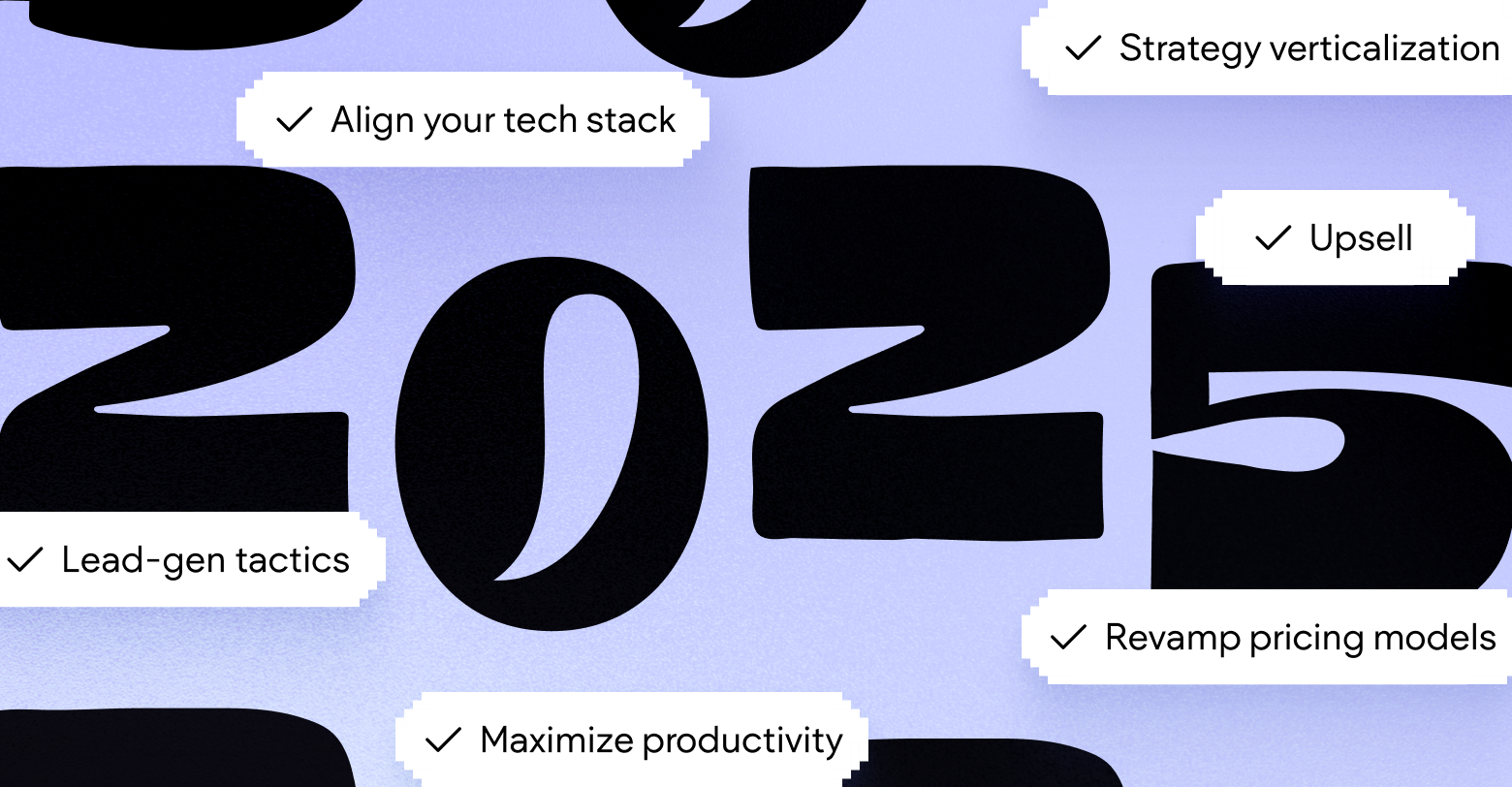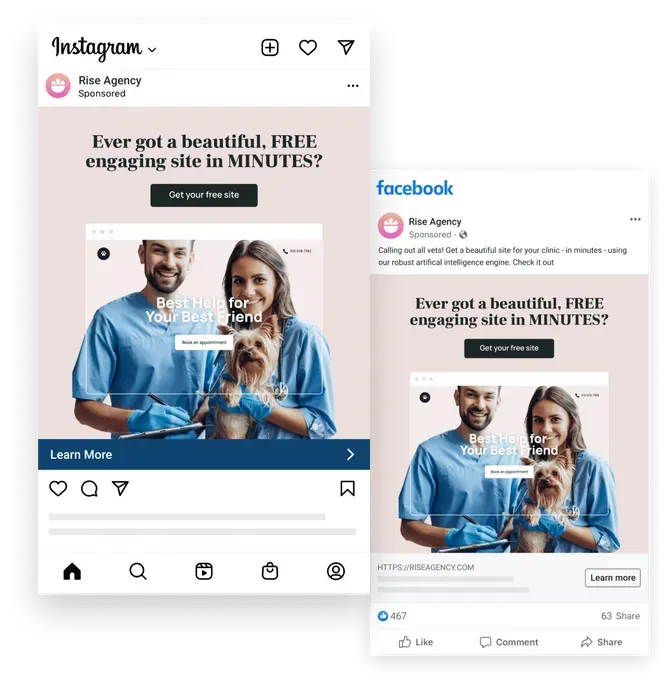I have a love-hate relationship with New Year’s resolutions. I love them because they’re a great way to set intentions and actually get things done. I hate them because, let’s face it, they’re often full of fluff and clichés.
So, to kick things off right, let’s first ditch the promises to 'work harder' or 'be better' (gee, why didn’t we think of that before?) and focus on what will actually drive growth for marketing agencies in 2025. This is the year to embrace resolutions that are concrete, actionable, and with a real chance of making a difference. From exploring automation and AI to breaking up with bad clients, this list is all about practical ways to level up your agency.
Ready to make 2025 your best year yet? Let’s get started.
1. This year… I will examine a verticalization strategy.
It’s no secret that niching down can be a game-changer for agencies. Verticalization—focusing your agency’s efforts on serving clients in a specific industry—allows you to build deeper expertise, streamline your processes, and market your services more effectively. It’s not about limiting your opportunities; it’s about honing in on the ones that are most profitable and rewarding. But let’s be clear: it’s not the right fit for everyone. This year isn’t about jumping headfirst into a vertical; it’s about taking the time to seriously explore whether it makes sense for your agency.
Start by analyzing your current client base. Are there industries where your agency consistently shines? Do you notice repeatable patterns in the challenges you solve for certain types of businesses? Diving into these trends can help you identify whether there’s a niche worth pursuing.
At the same time, weigh the potential downsides. Verticalization can mean narrowing your focus, which isn’t ideal if your agency thrives on variety or if your existing client base is too diverse to make the shift. That’s okay. The goal here isn’t to force a change but to invest time in understanding if this strategy could open up new opportunities for growth.
Moreover, verticalization isn’t an all-or-nothing decision. You don’t have to pivot overnight. Instead, consider gradually testing the waters: Run specialized marketing campaigns for a specific industry, create targeted case studies, or offer a tailored service package to see how it resonates.
This guide on choosing the right vertical market for your agency is a great starting point.
2025 might just be the year your agency finds its niche, its sweet spot—or it might not. Either way, the time spent evaluating this option will be worth it.
2. This year… I will upsell more.
If you’re not prioritizing upselling, you’re leaving money on the table. Studies show that the probability of selling to an existing customer is a whopping 60–70%, compared to just 5–20% for new prospects. Upselling isn’t just a smart strategy; it’s one of the most lucrative moves an agency can make.
Think of your existing clients as a goldmine of opportunities. They already trust you, value your work, and have a vested interest in enhancing their online presence. The key is to focus on their growing needs and offer upgrades that deliver clear value.
One highly effective upselling opportunity is transforming DIY websites into custom, advanced solutions. If your website builder supports upsell flows like these, all the better (Duda does, just sayin’). You can also pitch premium functionalities like eCommerce capabilities—seamlessly enabled with Duda’s robust feature set and tools.
Now, let’s linger for a moment on eCommerce capabilities. These are often assumed to only suit retail businesses, but that’s far from true.
Duda’s Transactional Sites, are a perfect upsell opportunity for service-based SMBs, including plumbers, lawyers, veterinarians, beauty salons, and real estate agents. These sites can be powerful
growth
drivers, enabling clients to sell digital products or services effortlessly. If you need inspiration, check out these
8 digital products your clients can start selling today.
Beyond that, explore the
Duda App Store to offer add-ons like chatbots, accessibility solutions, or advanced analytics. These enhancements not only enrich the client’s website but also position your agency as a long-term partner in their growth.
3. This year… I will take a deeper look at my agency’s pricing.
Let’s face it—pricing is a touchy subject. Many agency owners are reluctant to revisit it, either out of fear that raising rates will alienate clients or because it feels like a hassle. But here’s the truth: if you’re not actively reviewing your pricing, you might be missing out on valuable opportunities to maximize your revenue.
As an agency grows, costs inevitably creep up, especially wages and overheads. Yet, agencies are often hesitant to adjust their rates to reflect these changes, which leads to revenue growth at the expense of profit margins. This year, it’s important to balance revenue growth with higher profitability. A key part of this process is taking a hard look at your pricing structure and asking, "Is this still serving the business I’m building?"
Take the time to assess whether your current pricing still matches the quality and results you’re delivering. Clients who recognize your worth will be more than happy to invest in the solutions you provide.
Take a look at this guide on how to effectively price your agency’s services for growth, which explores different pricing strategies, from hourly rates to project-based and value-based models. There’s no one-size-fits-all approach, so it’s crucial to choose a pricing model that aligns with your business and client needs.
Additionally, think about offering tiered service packages that provide more flexibility while optimizing your revenue potential. By adjusting your offerings, you can better meet the needs of different client segments without losing out on premium opportunities. Here’s an example of how
one agency used a smart pricing strategy to grow their business.
4. This year… I will break up with some bad clients.
Whether they’re bad payers, consistently demanding but never satisfied, or create unnecessary stress for your team, bad clients can hold your agency back. So, this year, it’s time to reevaluate your
client relationships and make those tough decisions. Now, don’t get me wrong. This doesn’t mean you need to get rid of every client who’s challenging; some difficult clients can be managed with clear communication and boundaries. However, if a client consistently creates negative outcomes for your agency, cutting ties might be the healthiest option for both parties. Every agency’s definition of a bad client will be different, but trust your gut when deciding whether a client is really worth the stress.
To help you navigate this process, check out this blog on
how to fire a client professionally. It provides useful advice on how to handle these situations with grace and professionalism, ensuring that you leave the door open for future collaborations—just not in the current circumstances. Remember, parting ways with a client doesn’t have to be a dramatic exit.
5. This year… I will try creative lead-gen tactics.
I’ve discussed this in a previous article;
Top 11 tactics for lead generation for agencies, where I mentioned that agencies love referrals! In fact, that’s often their primary lead gen strategy. But what happens when referrals aren’t enough? It’s time to get creative.
This year, it’s time to mix things up. One option is paid marketing campaigns. Sure, they require a budget, but when you know your CPL and understand how much a sale brings in, you can quickly determine if the investment is worth it. In most cases, it is.
The real game-changer, though, is innovation. The competition for attention online is intense, and to break through, your campaigns need to offer something unique. For example, with Duda’s API, you can provide Instant Sites through PPC campaigns—prospects will see an ad offering them an instant site, like these ads:
They then fill out a quick form and receive a fully customized website in their inbox. It’s an irresistible offer that will get prospects excited.
Now, that’s just one example. I’m sure you can think of more. The idea is clear, though: it’s time to actively generate leads, and being creative about it is the way to go.
6. This year… I will make sure my tech stack aligns with my agency, not the other way around.
When evaluating and optimizing your agency’s tech stack, it’s crucial to choose tools that align directly with your workflow, goals, and unique needs. Your technology should be an enabler—making tasks easier, faster, and more effective—not something you constantly have to adjust your processes to fit.
As an agency-first website builder,
Duda prioritizes agency efficiency by providing a robust suite of tools designed specifically for agencies. The platform integrates a variety of features to streamline agency workflows and maximize productivity. You can read all about it in our blog:
Maximize your agency's potential: exploring Duda's top productivity-boosting tools & features.
One of the standout capabilities is automation—a key differentiator for agencies that build multiple websites. For example, you can
Dynamically create thousands of pages using a single design, automate sites creation with Zaps or
using Duda’s API and more.
And what about AI? It’s hard to talk about automation these days without mentioning AI. Even Duda’s advanced AI capabilities are geared toward agencies. For example, Duda’s AI SEO tools include automated generation of alt text and metadata for the entire site at once—this is a huge time-saver when managing large-scale web projects. This feature alone is a game-changer for agencies that handle high volumes of websites.
In short, your tech stack should help you work smarter, not harder—the agency way.
Here’s to 2025
Cheers to a year of no-nonsense growth and results! In 2025, it’s time to cut through the fluff and focus on what really drives success—actionable strategies, smarter tools, and bold decisions.
Oh… and do yourself a favor,
try Duda if you haven’t already—it’ll make your year 🙂








